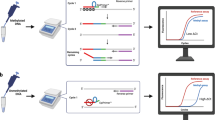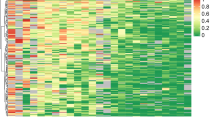Abstract
The human androgen-receptor gene (HUMARA) has been used for analysis of X chromosome inactivation (XCI) pattern because of a polymorphic short tandem repeat (STR) near the 5′-promoter region correlated with XCI. We introduce a novel method to analyze XCI pattern, named HUMARA methylation-specific PCR (HUMARA-MSP) assay, which analyzes methylation status of the HUMARA gene by bisulfite modification instead of a methylation-sensitive restriction enzyme. Although the original MSP method shows whether there is a methylated band or not, our HUMARA-MSP method identifies the patterns of methylated and unmethylated bands. Because this method identifies either unmethylated or methylated alleles in each PCR tube and shows opposite band patterns dependent on methylation status, we can assess the XCI pattern independently twice. This method can avoid false results by incomplete enzyme digestion and incomplete bisulfite modification will not affect the results. Extremely small quantities of samples, such as hematopoietic colonies, were also available for HUMARA-MSP assay. Because DNA modified by sodium bisulfite is also available for assessment of methylation status of other genes by setting specific primers for them, we performed the simultaneous assessment of clonality and aberrant hypermethylation of p15INK4B gene in myelodysplastic syndromes. These simultaneous assessments were easily possible and provided much information despite requiring only a small volume of DNA. The HUMARA-MSP assay may facilitate the analyses for pathogenesis of hematological disorders because of its simplicity, sensitivity and wide applicability.
This is a preview of subscription content, access via your institution
Access options
Subscribe to this journal
Receive 12 print issues and online access
$259.00 per year
only $21.58 per issue
Buy this article
- Purchase on Springer Link
- Instant access to full article PDF
Prices may be subject to local taxes which are calculated during checkout





Similar content being viewed by others
References
Kuiper GGJM, Faber PW, van Rooij HCJ, van der Korput JAGM, Ris-Stalpers C, Klaassen P, Trapman J, Brinkmann AO . Structural organization of the human androgen receptor gene J Mol Endocrinol 1989 2: R1–R4
Edwards A, Hammond HA, Jin L, Caskey CT, Chakraborty R . Genetic variation at five trimetric and tetrametric tandem repeat loci in four human population groups Genomics 1992 12: 241–253
Tilley WD, Marcelli M, Wilson JD, McPhaul MJ . Characterization and expression of a cDNA encoding the human androgen receptor Proc Natl Acad Sci USA 1989 86: 327–331
Allen RC, Zoghbi HY, Moseley AB, Rosenblatt HM, Belmont JW . Methylation of HpaII and HhaI sites near the polymorphic CAG repeat in the human androgen-receptor gene correlates with X chromosome inactivation Am J Hum Genet 1992 51: 1229–1239
Wang RYH, Gehrke CW, Ehrlich M . Comparison of bisulfite modification of 5-methyldeoxycytidine and deoxycytidine residues Nucleic Acids Res 1980 8: 4777–4790
Clark SJ, Harrison J, Paul CL, Frommer M . (1994) High sensitivity mapping of methylated cytosines Nucleic Acids Res 1994 22: 2990–2997
Herman JG, Graff JR, Myöhänsen S, Nelkin BD, Baylin SB . Methylation-specific PCR: a novel PCR assay for methylation status of CpG islands Proc Natl Acad Sci USA 1996 93: 9821–9826
Uchida T, Kinoshita T, Nagai H, Nakahara Y, Saito H, Hotta T, Murate T . Hypermethylation of the p15INK4B gene in myelodysplastic syndromes Blood 1997 90: 1403–1409
Ohashi H, Ichikawa A, Takagi N, Hotta T, Naoe T, Ohno R, Saito H . Remission induction of acute promyelocytic leukemia by all-trans-retinoic acid: molecular evidence of restoration of normal hematopoiesis after differentiation and subsequent extinction of leukemic clone Leukemia 1992 6: 859–862
Asano H, Ohashi H, Ichikawa M, Kinoshita T, Murate T, Kobayashi M, Saito H, Hotta T . Evidence for nonclonal hematopoietic progenitor cell populations in bone marrow of patients with myelodysplastic syndromes Blood 1994 84: 588–594
Quesnel B, Guillerm G, Vereecque R, Wattel E, Preudhomme C, Bauters F, Vanrumbeke M, Fenaux P . Methylation of the p15INK4b gene in myelodysplastic syndromes is frequent and acquired during disease progression Blood 1998 91: 2985–2990
Frommer M, McDonald LE, Miller DS, Collins CM, Watt F, Grigg GW, Molley PL, Paul CL . A genomic sequencing protocol that yields a positive display of 5-methylcytosine residues in individual DNA strands Proc Natl Acad Sci USA 1992 89: 1827–1831
Busque L, Zhu J, DeHart D, Griffith B, Willman C, Carroll R, Black PM, Gilliland DG . An expression based clonality assay at the human androgen receptor locus (HUMARA) on chromosome X Nucleic Acids Res 1994 22: 697–698
Robertson KD, Jones PA . Dynamic interrelationships between DNA replication, methylation, and repair Am J Hum Genet 1997 61: 1220–1224
Baylin SB, Herman JG, Graff JR, Vertino PM, Issa JP . Alterations in DNA methylation: a fundamental aspect of neoplasia AdvCancer Res 1998 72: 141–196
Gale RE, Fielding AK, Harrison CN, Linch DC . Acquired skewing of X-chromosome inactivation patterns in myeloid cells of elderly suggests stochastic clonal loss with age Br J Haematol 1997 98: 512–519
Busque L, Mio R, Mattioli J, Brais E, Blais N, Lalonde Y, Marlon M, Gilliland DG . Nonrandom X-inactivation patterns in normal females: lyonization ratios vary with age Blood 1996 88: 59–65
Zhu J, Frosch MP, Busque L, Beggs AH, Dashner K, Gilliland DG, Black PM . Analysis of meningiomas by methylation- and transcription-based clonality assays Cancer Res 1995 55: 3865–3872
Suzuki H, Asano H, Ohashi H, Kinoshita T, Murate T, Saito H, Hotta T . Clonality analysis of refractory anemia with ring sideroblasts: simultaneous study of clonality and cytochemistry of bone marrow progenitors Leukemia 1999 13: 130–134
Acknowledgements
We thank Sonoko Hatano and Kimie Kondo for their excellent technical assistance. This study was supported in part by Grants-in-Aid from the Ministry of Health and Welfare of Japan.
Author information
Authors and Affiliations
Rights and permissions
About this article
Cite this article
Uchida, T., Ohashi, H., Aoki, E. et al. Clonality analysis by methylation-specific PCR for the human androgen-receptor gene (HUMARA-MSP). Leukemia 14, 207–212 (2000). https://doi.org/10.1038/sj.leu.2401631
Received:
Accepted:
Published:
Issue Date:
DOI: https://doi.org/10.1038/sj.leu.2401631
Keywords
This article is cited by
-
Monoclonality and cytogenetic abnormalities in hyaline vascular Castleman disease
Modern Pathology (2014)
-
Heterogeneity of clonal expansion and maturation-linked mutation acquisition in hematopoietic progenitors in human acute myeloid leukemia
Leukemia (2014)
-
Newly diagnosed adult AML and MPAL patients frequently show clonal residual hematopoiesis
Leukemia (2013)
-
Biomarker analysis in polycythemia vera under interferon-alpha treatment: clonality, EEC, PRV-1, and JAK2 V617F
Annals of Hematology (2007)
-
Comparative genetic analysis of metachronous anaplastic oligoastrocytomas with extended recurrence-free interval
Journal of Neuro-Oncology (2005)



